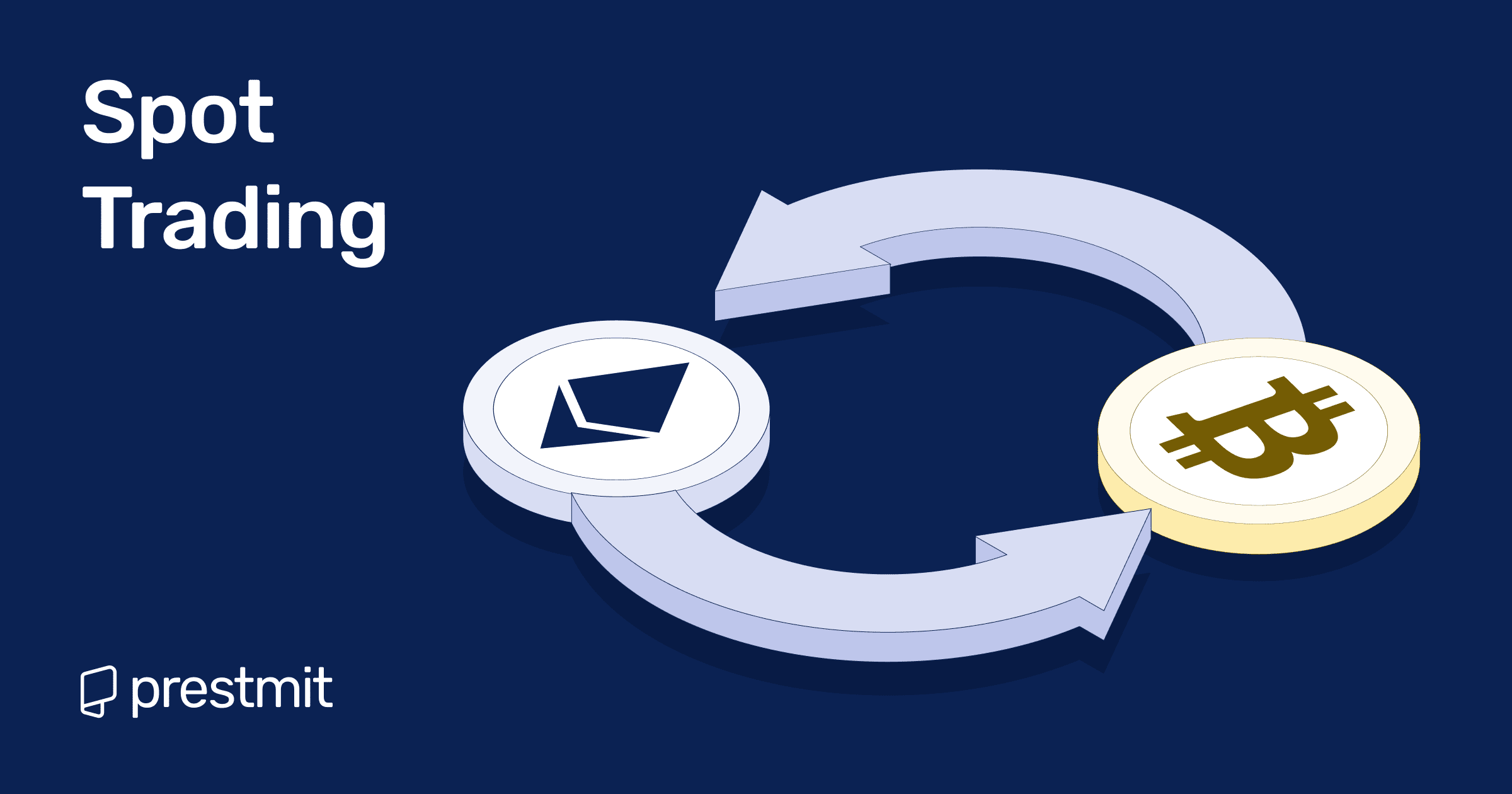Table of Contents
Over $1 trillion worth of crypto is traded monthly across global exchanges, and a big portion comes from spot trading. Some traders have been in the business for years but have yet to tap into the full potential of spot trading.
Spot trading is a strategic investment outlook that makes it simple for investors to buy and sell financial assets. A spot transaction is often the first step in the cryptocurrency trading process for many people. HODLing a cryptocurrency is purchasing it at the current market price and holding on to it until its value increases.
In this article, we will go over crypto spot trading and contrast it with CFD trading to show the differences between the two concepts.
What Is Spot Trading In Cryptocurrency?

Spot trading means purchasing and selling crypto assets at the current market price (spot price) and having the asset delivered immediately.
The spot market is where real-time trading happens. It’s like a local food market where you can walk in, pay cash, and walk away with some fruits. In crypto, it’s the digital version of that. You buy a coin at the current market price (the spot price) and take immediate ownership.
Unlike futures or options, there’s no speculation on future prices—just you and the coin. That’s what makes it simple and transparent. It doesn’t matter if you’re buying Bitcoin on Binance or swapping Ethereum on a DEX; you’re in the spot market.
The spot market is considered the foundational layer of crypto trading, especially for starters who prefer to escape the complexity and jump right into the real deal.
What Is A Spot Market?
In a spot market, traders can buy and sell an asset at current market prices. Transactions in the crypto spot market are settled immediately after the buyer’s and seller’s orders are filled. There must be buyers and sellers, as well as an order book, in a spot market.
In the crypto spot market, you have the option of trading a variety of different cryptocurrencies in a variety of other pairs.
There is a lot of volatility in the crypto spot market caused by traders’ market sentiments. Traders are influenced by a variety of factors that influence their decisions to either buy or sell. Different fundamental and technical analysis techniques are commonly used by spot traders when making trading decisions.
Where To Trade Crypto Spot Market
Crypto spot markets are available on Over counter, peer-to-peer, centralised, and decentralised exchanges.
1. Over Counter (OTC)
In the counter-spot market, transactions are carried out directly between two parties. By quoting different prices at which they are willing to buy or sell a cryptocurrency, dealers/brokers serve as the market makers. Trades on the OTC market are often cheaper than those on the stock exchange, and the transaction price is not always made public.
As opposed to the exchange-based market, OTC spot markets are privately held and subject to less regulation. To top it all off, they allow investors to buy and sell more significant amounts of cryptocurrency with less impact on the market’s overall value.
2. Peer-to-Peer (P2P)
Peer-to-peer trading enables cryptocurrency traders to trade with each other. Peer-to-peer trading, like over-the-counter trading, does not require the involvement of a third party or intermediary.
In P2P trading, you can choose sellers, buyers, settlement times, pricing, and payment methods that best suit your needs. To facilitate smoother trades, buyers and sellers are required to use preferences in the creation of bids and offers.
3. Centralized Exchanges (CEXs)
Traditional stock markets and online brokerages use the order book model to match buyers and sellers in large-scale cryptocurrency transactions, just like centralised exchanges.
Additionally, CEXs offer custody services by allowing customers to deposit and store their crypto assets on their platform. Faster trading times, increased security, and customer protection are all benefits of centralised exchanges. CEXs charge users transaction fees on every trade they make to provide these services. Accessing the crypto spot market is currently easiest through Cass.
4. Decentralized Exchanges (DEXs)
Without brokers or intermediaries, you can access the spot crypto market through decentralised exchanges. Users typically trade against the liquidity of a type of smart contract known as an automated market maker, as opposed to the traditional P2P or CEX method (AMMs).
To trade cryptocurrencies, users don’t have to hand over any money from their wallets. Decentralized exchanges allow you to participate in the spot market without giving up your privacy or exposing yourself to the risk of a counterparty.
The costs of trading on DEXs are typically lower. Transaction fees, however, can skyrocket if there is massive traffic on blockchain networks. As with their centralised counterparts, DEXs can have inferior liquidity and are not always as user-friendly as they could be.
Benefits Of Spot Trading In Cryptocurrency
Spot trading offers several advantages, making it a favorite among crypto enthusiasts and traditional investors.
- In Spot Trading, you gain full ownership of the asset you buy. You can transfer it to your wallet, stake it, or sell it at your convenience.
- It offers transparency. There is no speculating or borrowing; you’re trading based on the market price.
- It offers less risk because there is no leverage, so you don’t have to worry about getting liquidated if the prices drop.
- The process is easy to navigate. With just a few clicks, you can purchase, sell, and track your assets without worrying about expiry dates, funding rates, or margin calls.
Risks Of Spot Trading In Cryptocurrency
Let’s face the facts: Spot trading is easy and fairly rewarding, but not without risks. Here are some of the risks:
- CFD (contracts for difference) and futures trading are more flexible than spot trading.
- Cryptocurrency spot trading is unregulated in many countries around the world.
- The gains that can be made in the spot market are smaller than those that can be made in CFDs or on margin.
Difference Between Spot Trading In Cryptocurrency And Crypto CFDs
Many financial derivatives enable traders to speculate on cryptocurrency prices without owning the underlying asset, such as crypto CFDs (contracts for difference).
As a form of collateral, traders place a small amount of an asset’s value as a bet on the movement of a cryptocurrency’s price. Traders are compensated for any difference between the opening and closing prices if they succeed in their trade. If the work goes against the trader, the trader pays the broker the difference. Multiplying the change in the asset’s value by the quantity yields a profit (or loss).
The use of leverage by traders is a significant difference between crypto spot trading and CDs. Using leverage on CFDs, traders can increase their profits while putting up little or no money. Leverage, on the other hand, can magnify both gains and losses.
In contrast, leverage is unavailable in crypto spot trading, so you can only profit from price increases. This means that you can use the asset in other ways if you choose to do so while trading.
For the most part, unlike crypto CFDs, where holding positions overnight incurs an interest swap fee, spot trading does not charge any fees for holding classes.
It is possible to gain exposure to the crypto market through crypto spot trading and crypto CFDs. Your investment approach and strategy will determine which of these two options is best for you.
Frequently Asked Questions (FAQs) About Spot Trading
How can I earn from spot trading?
You earn from spot trading by buying low and selling high. But don’t just take my word for it, you need to be strategic and calculative in this trade. I usually look for dips after major news events and then hold until momentum returns. You can earn through staking or yield farming with the coins you buy.
You can blend this with a spot trading crypto strategy like dollar-cost averaging, and you’re in business.
Is crypto spot trading profitable?
Yes, but like all investments, it depends on timing, research, and risk management. If you ask any professional the question, “Is spot trading profitable?” They will tell you yes, but with patience and a good plan. You need to be focused and consistent, and your reward will come.
How can I start spot trading as a beginner?
Pick a trusted exchange like Binance, create an account, complete a KYC (know your customer) procedure, fund your wallet, and start small. Begin with stablecoins or major assets like BTC or ETH. Use limit orders to buy at good prices and keep track of news that can affect the market.
Many platforms now provide guides labeled spot trading for beginners; you can search for such platforms and begin from there.
Conclusion
Spot trading is a good place to start if you want to build an empire of crypto investing. It is simple, straightforward, and highly promising. Whether you are an investor who likes to hold coins for an extended period or you flip them for short-term gains, with Spot Trading, you can wield control, ownership, and transparency.
I’ve made mistakes and won in my journey, but this magnificent joy comes from buying real coins and watching them grow. So, you still belong to the leagues that doubt or ask questions like “Is crypto spot trading profitable? “ Think again!
If I were you right now, I’d quickly set short-term and long-term goals, then take time to study the game. After that, I’d take a bold step and make my first trade. If you do these simple things, you will be amazed at what you will achieve financially after 1-2 years.
Last updated on August 14, 2025

